Security officers in Stalingrad. The feat of the 10 Division of the troops of the NKVD of the USSR
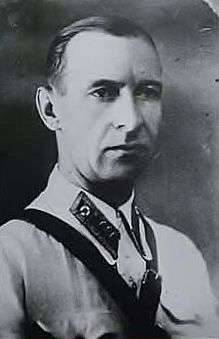
The troops of the NKVD of the USSR were under the operational control of the ten main directorates of the People's Commissariat and included border, operational (internal), escort, security, railway and some others. The most numerous were the frontier troops, numbering 22 1941 167 people on 582 in June XNUMX of the year.
Since at the end of 1940, foreign intelligence (the 5 department of the GUGB NKVD of the USSR) announced the signing by Hitler 18 of December 1940 of Directive No. 21 "Barbarossa Variant", Commissar Lavrenty Beria took the necessary measures to convert the NKVD troops into special elite units to change the NKVD troops into special elite units to change the NKVD troops into special elite units . Thus, in February 28, 1941 from the border troops were allocated operational troops, which included one division (OMSDON Dzerzhinsky), 17 individual regiments (including 13 motorized rifle), four battalions and one company. Their number on 22 June was 41 589 people.
At one time, even before joining the border troops, the task of the operational forces was the fight against banditry - the detection, blocking, prosecution and destruction of gangs. And now they were intended to strengthen the border units during the hostilities at the border. The operational forces were armed Tanks BT-7, heavy guns (up to 152 mm) and mortars (up to 120 mm).
“The frontier troops entered the battle first, not a single frontier unit departed,” writes Sergo Beria. - On the western border, these units restrained the enemy from 8 to 16 hours, in the south - up to two weeks. Here not only courage and heroism, but also the level of military training. And by itself there is no question why the frontier guards at the outposts have artillery. The howitzers, as they say, were not there, but the outpost's anti-tank guns had. Father insisted on this before the war, knowing full well that you would not go to the tank with a rifle at the ready. A howitzer regiments were attached to the border detachment. And it also played a positive role in the first battles. Army artillery, unfortunately, did not work ... ".
By resolution of the Council of People's Commissars of the USSR No. 1756-762ss of 25 of June 1941, the troops of the NKVD of the USSR entrusted the protection of the rear of the existing Red Army. In addition, Stalin considered the fighters in green and cornflower caps as the last reserve, which was sent to the most threatened sectors of the front. Therefore, the formation of new motorized rifle divisions of the NKVD began, the backbone of which was made by the border guards.
So, in the order Beria from 29 June 1941 of the year said:
“For the formation of the above divisions, select from the cadres of the NKVD troops for 1000 people of private and junior commanding staff and for 500 people of the commanding staff for each division. For the rest of the composition to submit applications to the General Headquarters of the Red Army for the conscription from the reserve of all categories of servicemen. ”
Nevertheless, the total number of NKVD troops during the war did not exceed 5 – 7% of the total number of Soviet armed forces.
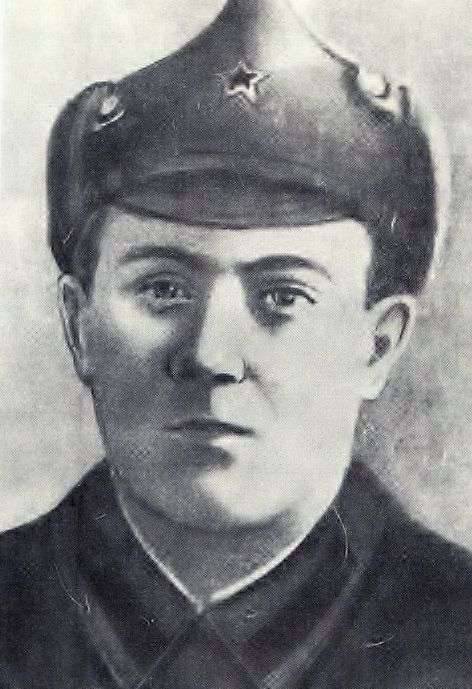
Four divisions, two brigades, separate regiments and a number of other units of the NKVD troops participated in the defense of Moscow. The NKVD troops fought desperately and near Leningrad, defending the city and guarding communications. Security officers stood to death, never surrendering to the enemy and not retreating without orders.
After the defeat of the German troops near Moscow and the Red Army launched an offensive by decree of the State Defense Committee of the USSR No. 1092ss of 4 in January 1942, in the cities liberated by the Red Army, garrisons were exhibited from the personnel of the internal troops of the NKVD, who were given the following tasks:
- carrying garrison (guard) service in the liberated cities;
- Assisting the NKVD in identifying and seizing enemy agents, former fascist accomplices;
- the elimination of airborne assault, sabotage and reconnaissance groups of the enemy, gang formations;
- maintaining public order in the liberated territories.
It was assumed that the Red Army would continue the successful offensive, so that 10 rifle divisions, three separate motorized rifle divisions and one rifle regiments were formed as part of the internal troops of the NKVD to accomplish the tasks.
The 10 Rifle Division of the NKVD of the USSR formed February 1 1942 of the year on the basis of the order of the NKVD of the USSR No. 0021 of January 5 of 1942 of the year. The division management, as well as the 269 and 270 rifle regiments of the internal troops of the NKVD of the USSR were established in Stalingrad according to the mobilization plan of the UNKVD apparatus in the Stalingrad region.
In this regard, a large group of employees of local units of the internal affairs and state security bodies were sent to the ranks of their personnel as a marching replenishment. The 271, 272 and 273 infantry regiments arrived from Siberia: from Sverdlovsk, Novosibirsk and Irkutsk, respectively. In the first half of August, the 282 th infantry regiment arrived, formed in Saratov, which replaced the declining 273 th regiment.
Statewide, all the regiments consisted of three infantry battalions, a four-gun 45-mm anti-tank gun, a mortar company (four 82-mm and eight 50-mm mortars) and a company of machine gunners. In turn, each rifle battalion consisted of three rifle companies and a machine-gun platoon armed with four Maxim machine guns. The total strength of the division on 10 August 1942 of the year was 7568 bayonets.
In the period from 17 to 22 in March, 1942, 269, 271 and 272 regiments took part in a large-scale operational and preventive operation carried out in Stalingrad under the general leadership of Deputy Commissar of Internal Affairs of the USSR, state security Commissar of 3 rank Ivan Serov . In fact, a thorough sweep of the city from the "criminal element" was made. This revealed 187 deserters, 106 felons and 9 spies.
After a successful counter-offensive near Moscow, the Soviet high command found it possible to continue offensive operations on other sectors of the front, in particular, near Kharkov by the forces of the Bryansk, South-Western and Southern fronts under the command of Marshal of the Soviet Union Semyon Timoshenko, chief of staff - Lieutenant-General Ivan Bagramyan, Member of the Military Council - Nikita Khrushchev. On the German side, they were opposed by Army Group South forces: 6-I army (Friedrich Paulus), 17-I army (Hermann Goth) and 1-I tank army (Ewald von Kleist) under the overall command of Field Marshal Fyodor von Boca.
Kharkiv operation began on 12 May 1942. The common task of the advancing Soviet troops was to surround Paulus’s 6 Army in the Kharkiv region, which would further cut off Army Group South, press it to the Sea of Azov and destroy it. However, in May 17, Kleist’s 1 I tank army struck the rear of the advancing units of the Red Army, broke through the defenses of the 9 Army of the Southern Front, and by May 23 cut off Soviet troops to the east.
Colonel-General Alexander Vasilevsky, the Chief of the General Staff, proposed to stop the offensive and withdraw the troops, but Tymoshenko and Khrushchev reported that the threat from the southern group of the Wehrmacht was exaggerated. As a result, by May 26 the surrounded units of the Red Army were locked up in a small area of 15 km2 in the area of Barvenkovo.
Soviet losses amounted to 270 thousand people and 1240 tanks (according to German data, only 240 thousand people were taken prisoner). Killed or missing: Deputy Commander of the Southwestern Front, Lieutenant-General Fedor Kostenko, Commander of the 6 Army, Lieutenant-General Avksenty Gorodnyansky, Commander of the 57 Army, Lieutenant General Kuzma Podlas, Commander of the Army Group Major-General Leonid Bobkin and a number of generals, commanded by encircled divisions. The Germans lost 5 thousand killed and about 20 thousand wounded.
Because of the disaster near Kharkov, the rapid advance of the Germans to Voronezh and Rostov-on-Don with the subsequent access to the Volga and the Caucasus (Operation Fall Blau) became possible. 7 July the Germans occupied the right bank of Voronezh. 4-I tank army Goth turned south and rapidly moved to Rostov between the Donets and Don, smashing the retreating parts of the South-Western front of Marshal Tymoshenko along the way. Soviet troops in the vast desert steppes were able to oppose only weak resistance, and then completely began to flock eastward in complete disarray. In mid-July, several Red Army divisions fell into a boiler in the Millerovo area. The number of prisoners during this period is estimated to be from 100 to 200 thousands.
On July 12, the Stalingrad Front was created (commander - Marshal S.K. Timoshenko, member of the Military Council - N.S. Khrushchev). It included the garrison of Stalingrad (10th division of the NKVD), the 62nd, 63rd, 64th armies, formed on July 10, 1942 on the basis of the 7th, 5th and 1st reserve armies, respectively, and several others formations from the Army Group of the Reserve VGK, as well as Volzhskaya flotilla. The front received the task of stopping the enemy, preventing him from reaching the Volga, and firmly defending the line along the Don River.
On July 17, the avant-gardes of the Paulus 6 Army reached the advanced units of the 62 and 64 armies. The battle of Stalingrad began. By the end of July, the Germans pushed the Soviet troops behind the Don. 23 July fell Rostov-on-Don, and the 4-I tank army of Gotha turned north, and the 6-I army of Paulus was already a few dozen kilometers from Stalingrad. On the same day, Marshal Timoshenko was removed from the command of the Stalingrad Front. 28 July Stalin signed the famous order number 227 "Not one step back!".
On August 22, the 6th Army of Paulus crossed the Don and captured a bridgehead 45 km wide on its eastern shore. On August 23, the 14th Panzer Corps of the Germans broke through to the Volga north of Stalingrad, near the village of Rynok, and cut off the 62nd Army from the rest of the forces of the Stalingrad Front, like a steel horseshoe chained to the river. Enemy aviation dealt a massive blow to Stalingrad from the air, as a result of which entire blocks turned into ruins. A huge fiery whirlwind was formed, which completely burned down the central part of the city and all its inhabitants.
The first secretary of the Stalingrad regional party committee, Alexey Chuyanov, recalled:
“The military thunderstorm moved into the city with such speed that we could really oppose the enemy only the 10 division of the NKVD troops under the command of Colonel Sarajev.” According to the memoirs of Alexander Sarayev himself, “the warriors of the division carried the guard service at the entrances to the city, at the crossings over the Volga, patrolling the streets of Stalingrad. Much attention was paid to combat training. We set ourselves the task in a short time to prepare the fighters of the division to fight with a strong, technically equipped opponent. ”
The division stretched for 50 km and occupied the defenses along the city bypass of the fortifications.
The first battle with the enemy took place on 23 in August in the northern part of the city in the area of the Stalingrad Tractor Plant, where the Germans were blocked by the 282 Infantry Regiment of the 10 Division of the NKVD USSR (commanded by Major Mitrofan Grushchenko) with the support of the Stalingrad workers of Stalingrad, among which were Defense Tsaritsyn. At the same time at the tractor factory continued to build tanks, which were staffed with crews, consisting of factory workers, and immediately sent off the assembly lines into battle.
Among the heroes of the first battles are the chief of staff of the regiment, Captain Nikolai Belov:
"In the course of organizing the defense, the regimental divisions were wounded, lost sight, but did not leave the battlefield, continued to manage the regiment's combat operations" (TsAMO: f. 33, op. 682525, d. 172, l. 225).
As of October 16, in the regiment that had been surrounded by that time, less than a platoon remained in the ranks - only the 27 security officers.
The most famous, 272 th Infantry Regiment of the 10 Division of the NKVD of the USSR, later received the honorary military name "Volzhsky", commanded by Major Grigory Savchuk, by 24 of August with its main forces dug in at the turn of the Experimental Station - the height of 146,1. 4 September a large group of enemy machine guns managed to break through to the regiment's checkpoint and take it into the ring.
The situation was saved by the battalion commissar Ivan Shcherbina, the commissar of the regiment who raised the staff workers in hostility. He in the ensuing melee personally destroyed three Germans, the rest turned to flight. The plans of the Nazis for a breakthrough in the city center and the seizure of the main city ferry across the Volga failed.
In letters of gold in the chronicle of the battle of Stalingrad, the name of an automaton of the 272 regiment Alexei Vashchenko is inscribed: 5 of September 1942 of the year during the assault on the height of 146,1 with a cry “For Motherland! For Stalin! ”With his body he closed the embrasure of the bunker. By order of the troops of the Stalingrad Front No. 60 / n from October 25 1942, he was posthumously awarded the Order of Lenin. Today the name of the hero is one of the streets of Volgograd.
In a fierce battle at the Experimental Station against our battalion, the Germans threw 37 tanks. Six of them flamed from the fire of anti-tank guns, grenades and a combustible mixture of “KS”, but the rest broke into the location of our defense. At a critical moment, the junior political instructor, assistant to the Komsomol work in the regiment, Dmitry Yakovlev, rushed under a tank with two anti-tank grenades and blew himself up along with the enemy machine.
The 269 th rifle regiment of the 10 division of the NKVD of the USSR under the command of Lieutenant Colonel Ivan Kapranov ensured law and order in Stalingrad and suburban settlements of Kotluban, Gumrak, Orlovka, Dubovka and Gorodishche, as well as in the crossings of the crossing point from July to August and August. Mechekka. During this period, 1 people were detained, including 23 military personnel and 2733 civilian.
23 August 1942, the regiment urgently took up defense around the height of 102,0 (aka Mamaev Kurgan). 7 September in 5: 00 began a massive German offensive on Stalingrad from the line of Gumrak - Razgulyaevka: to 11: 00 - artillery preparation and incessant bombing, with the bombers approaching the target using 30 – 40 echelons of aircraft. And in 11: 00, the enemy infantry rose to the attack. The 112-I Rifle Division defending ahead of the “cornflower blue caps” quivered, and the Red Armymen “throwing in panic weapon, fled from their defensive lines in the direction of the city ”(RGVA: f. 38759, op. 2, d. 1, l. 54ob).
To stop this unorganized retreat, the 1-th and 3-th battalions of the 269-th regiment of the 10-division of the NKVD of the USSR had to temporarily leave the trenches and live chain to face the runners under the torn bombs and shells. As a result, about nine hundred members of the Red Army, including a significant number of officers, were stopped and re-assembled into subunits.
September 12 The 10 Division of the NKVD of the USSR entered the operational subordination of the 62 Army (Commander - Lieutenant-General Vasily Chuykov). 14 September in 6: 00 from the line of the Historical Val was hit with a knife in the heart of the city - its central part with a group of the tallest stone buildings dominating next to them the height of 102,0 (Mamayev Kurgan) and the main crossing over the Volga.
Especially strong battles were fought over Mamayev Kurgan and in the area of the Tsaritsa River. This time the main attack of the 50 tanks fell at the junction between the 1 and 2 battalions of the 269 regiment. In 14: 00, two battalions of enemy riflemen with three tanks went into the rear of the regiment and occupied the summit of Mamayev Kurgan, opening fire on the village of the Krasny Oktyabr factory.
To regain the height, a company of machine gunners from the 269 th regiment of junior lieutenant Nikolai Kubezny and the 416 th rifle regiment of the 112 th rifle division with two tanks went to the counterattack. K 18: 00 height has been cleared. The defense on it was taken by the 416-th regiment and partly by units of the KGB. In two days of fighting, the 269 th regiment of the 10 th division of the NKVD of the USSR destroyed more than one and a half thousand soldiers and officers, knocked out and burned about the enemy's 20 tanks.
Meanwhile, a separate group of German machine gunners penetrated into the city center, intense fights were going near the station. Having created strongholds in the building of the State Bank, in the House of Specialists and a number of others, on the upper floors of which fire spotters sat down, the Germans took fire at the central crossing over the Volga. They managed to get very close to the landing site of the 13 Guards Division, Major General Alexander Rodimtsev. As Alexander Ilyich himself wrote, “this was a critical moment when the fate of the battle was decided, when one extra grain could pull the scales of the enemy. But he did not have this pellet, but Chuikov had it. ”
On a narrow strip of coast from the House of Specialists to the NKVD complex of buildings, the crossing was defended by the combined squadron of the 10 Division of the NKVD of the USSR under the command of Ivan Petrakov, State Security Captain, who, in fact, saved Stalingrad at a crucial moment of the battle. A total of 90 people - two incomplete platoons of the 10 division of the NKVD division, workers of the regional NKVD Directorate, city policemen and five firefighters repulsed attacks of the 1 battalion of the 194 infantry division of the 71 th army of the Wehrmacht. In the official stories it sounds like this: "We ensured the crossing of units of the 13 Guards Division ...".
This means that at the last moment, at the last turn of 90, the security officers stopped an entire army that captured the whole of Europe ...
At the same time, despite the overwhelming advantage of the Germans, a squad of security officers goes on the attack in the brewery area, beats off two of our guns previously captured by the Germans, and starts to beat them into the State Bank building, from the upper floors of which the Germans correct the shelling of the pier and the central crossing. To the aid of the Chekists, Vasiliy Ivanovich Chuikov throws his last reserve, a group of three T-34 tanks under the command of Lieutenant Colonel Matthew Weinrub with the task of attacking the high buildings on the embankment captured by the Germans.
At this time, on the left bank of the Volga, Deputy Front Commander Lieutenant-General Philip Golikov arrives at Rodimtsev, entrusted with the task of transporting the 13 Guards Division to Stalingrad.
- See that shore, Rodimtsev?
- I see. I think the enemy went to the river.
- It does not seem, but it is. So make a decision - both for yourself and for me.
At this moment, a German mine enters a nearby barge. Screams are heard, something heavy flops into the water, and a huge torch flashes the food.
- And what will I do with the ferry? - with bitterness says Golikov. - Artillery ponavezli all, up to the main caliber. But whom to shoot? Where is German? Where is the cutting edge? In the city there is one bloodless division of Colonel Sarayev (10-division of the NKVD) and thinned out militia units. That's the whole sixty-second army. There are only pockets of resistance. There are joints, but what the hell are the joints - the holes between the units of several hundred meters. And Chuikov has nothing to patch them ...
On the opposite bank, the defense at the turn: the cemetery with its surroundings, the village of Dar-gora — the NKVD House — the central part of the city — is occupied by units of the 270 regiment of the 10 division of the NKVD commanded by Major Anatoly Zhuravlev. From July 25 to September 1, they served as a barrier service in the operational rear of the 64 Army and then were transferred to Stalingrad. September 15 in 17: 00 the Germans struck them two simultaneous strikes - on the forehead and a roundabout - from the side of the NKVD House.
At the same time, the 2 Battalion was attacked in the back by ten tanks. Two of them managed to set on fire, but the remaining eight vehicles managed to break through to the position of the 5 of the company, where the caterpillars buried alive in the trenches to two platoons of personnel. In the twilight, only ten miraculously survived in that terrible meat grinder of the security officers of the 2 company managed to gather at the command post of the 5-th battalion.
The captain Vasily Chuchin, the chief of staff of the regiment, was seriously wounded, who suffered from the local use of chemical warfare agents by the enemy. With his order from September 20, the commander of the 10 division of the NKVD USSR, Colonel Alexander Sarayev, poured the remnants of the 270 regiment into the 272 regiment. A total of 109 people were transferred there with two “forty-five” guns and three 82-mm mortars ...
The 271 Infantry Regiment of the 10 Division of the NKVD of the USSR, commanded by Major Alexei Kostinitsyn, took up defensive positions along the southern outskirts of Stalingrad. September 8 after a massive air raid on it moved the enemy infantry. 12 and 13 September the regiment fought in the semiring, and from September 15 in almost two days - in the ring of the environment. The fighting took place these days near the bank of the Volga, on the patch within the borders of the elevator - a railway crossing - a cannery.
This forced to throw into battle and staff workers. The hero of those days was the clerk of the political regiment of the regiment sergeant of state security Sukhorukov: on September 16, during a fire attack from a machine gun, he destroyed six fascists, and then in the melee already three of them. In total, at his personal account in the September battles, he recorded seventeen killed enemy soldiers and officers!
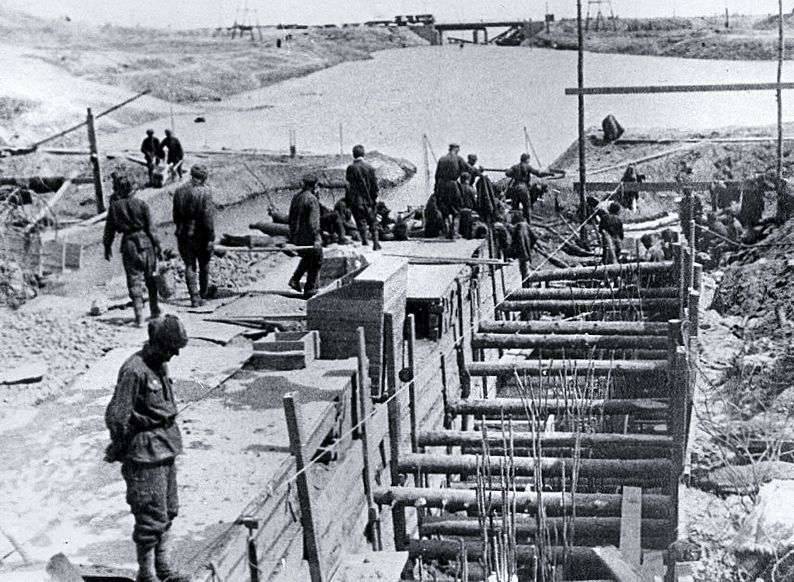
At the same time, the 272 th Volzhsky Regiment was being dug in at the turn of Stalingrad-1 Station - a railway bridge across the Tsaritsa River. September 19 is wounded by the regimental commander, Major Grigory Savchuk, and at the head of the regiment is the military commissar - battalion commissar Ivan Shcherbina. Positioning the command post for the regimental headquarters in the bunker of the former command center of the city defense committee in Komsomolsky Garden, Ivan Mefodiyevich writes his famous note, now kept in the Museum of Border Troops in Moscow:
"Hello friends. Germans beat, surrounded by a circle. Not a step back is my duty and my nature ...
My regiment did not disgrace and disgrace Soviet weapons ...
Tov. Kuznetsov, if I died - my only request - the family. My other sadness would be to give the bastards more teeth, i.e. I regret that I died early and the Nazis killed only 85 in person.
For the Soviet Motherland, guys, beat the enemies !!! ”
On September 25, the enemy’s tanks took a KP into the ring and began shooting it at close range from tower guns. In addition, chemical warfare agents were used against the defenders. After several hours of being under siege, I.M. Shcherbina led the surviving staff workers and 27 headquarters security fighters for a breakthrough. They pierced their way with bayonets. Unfortunately, the brave commissar in that unequal battle died a brave death: enemy bullets fatally wounded him at the Gorky Theater ...
During 26 September, the remnants of the regiment in the number of 16 fighters under the command of junior political officer Rakov steadfastly held in the half-circle on the banks of the Volga until the evening, while fragments of two neighboring separate rifle brigades of the Red Army defeated by the enemy, hastily escaped to the left bank. A handful of brave KGB soldiers destroyed the Nazis to the company and destroyed two enemy machine guns.
The main task is to keep the city until the fresh reserves of the 62 Army are in place - the 10 Infantry Division of the NKVD of the USSR performed with honor. Of the 7568 fighters who joined the 23 August 1942, about 200 people survived. October 26 1942 was the last on the left bank of the Volga to withdraw control of the 282 regiment, which defended the height of 135,4 from the tractor factory. However, in the burning Stalingrad, the consolidated company of the regiment in the number of 25 bayonets, formed from the remnants of the consolidated battalion, remained to fight. The last warrior of this company was out of action due to the injury of 7 November 1942.
The 10 Rifle Division of the internal troops of the NKVD of the USSR was the only one of all the formations participating in the Battle of Stalingrad that was awarded the Order of Lenin to 2 in December 1942 of the year. Hundreds of soldiers of the division were awarded orders and medals. 20 Chekists Division awarded the title Hero of the Soviet Union, five people became holders of the Orders of Glory of all three degrees.
December 28 1947 of the year in Stalingrad, on the right bank of the Tsaritsa River, unveiled a monument to the Chekists. Around the monument is arranged the square of the Chekists with a small park area. Stairs lead to the monument from four sides. The majestic five-meter bronze figure of a KGB warrior towers on a seventeen meter high architecturally designed pedestal in the shape of an obelisk. The Chekist holds a drawn sword in his hand.
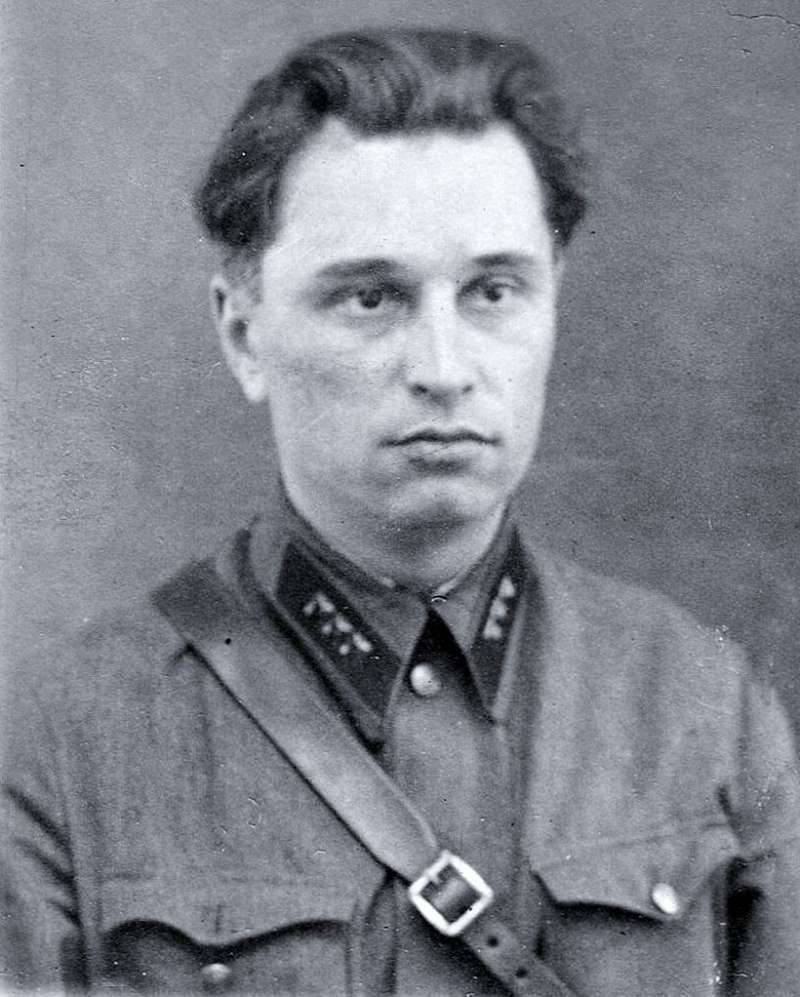
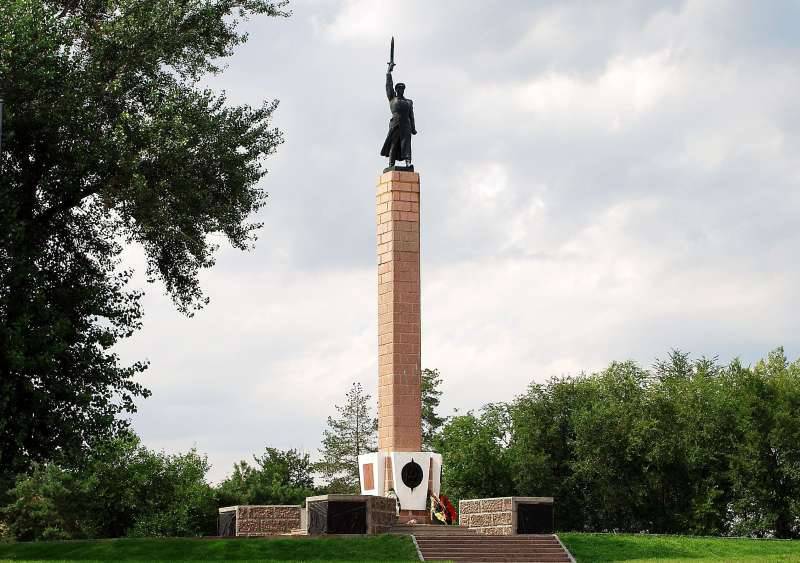
Information